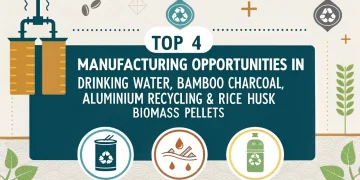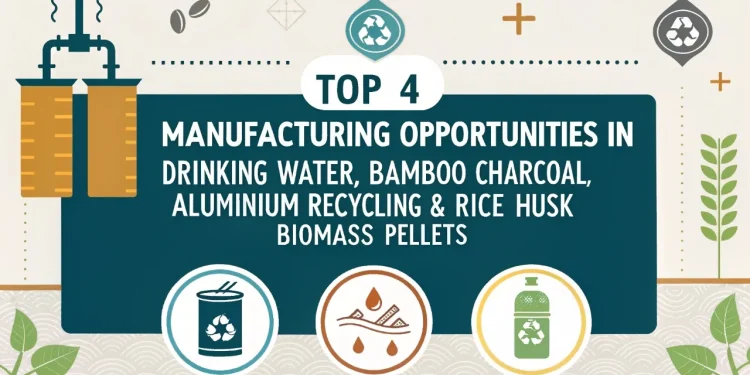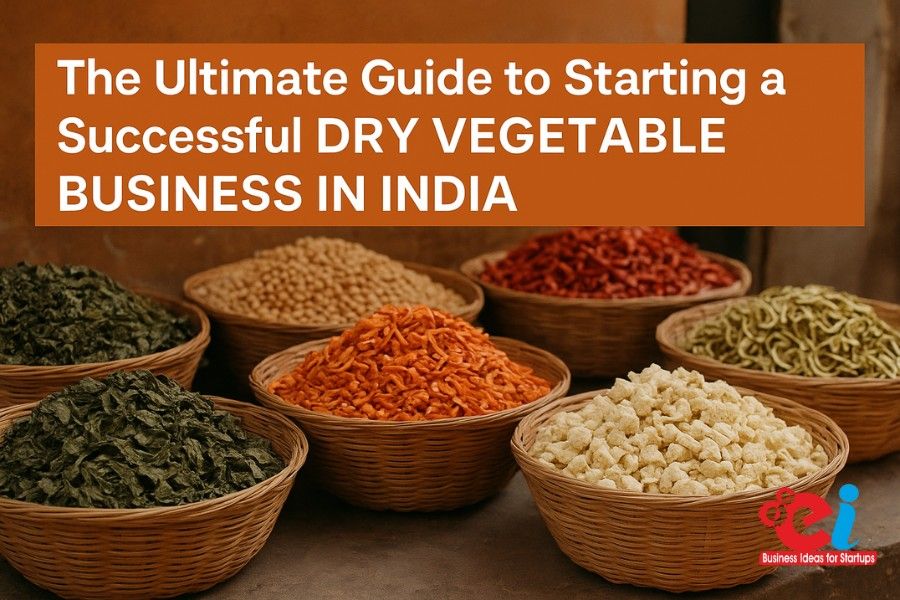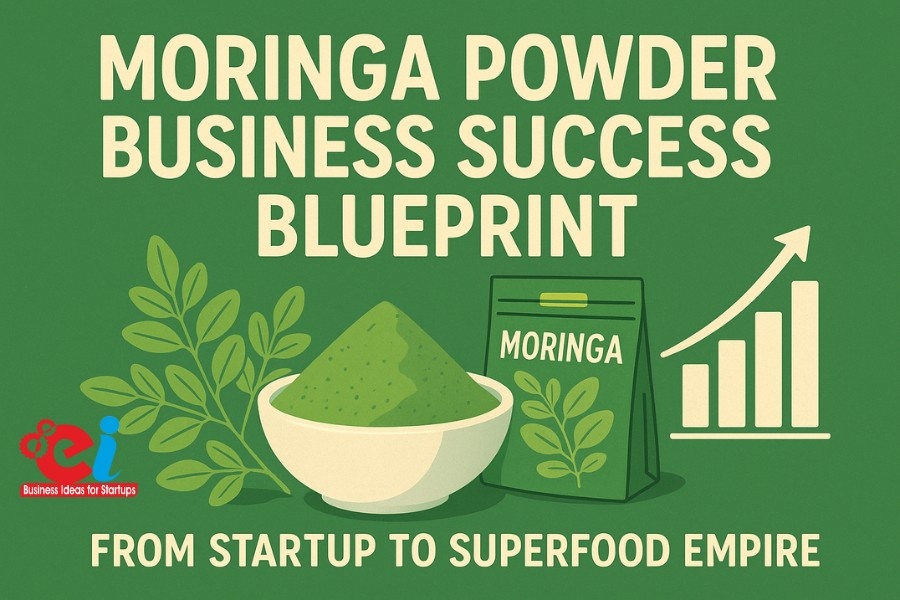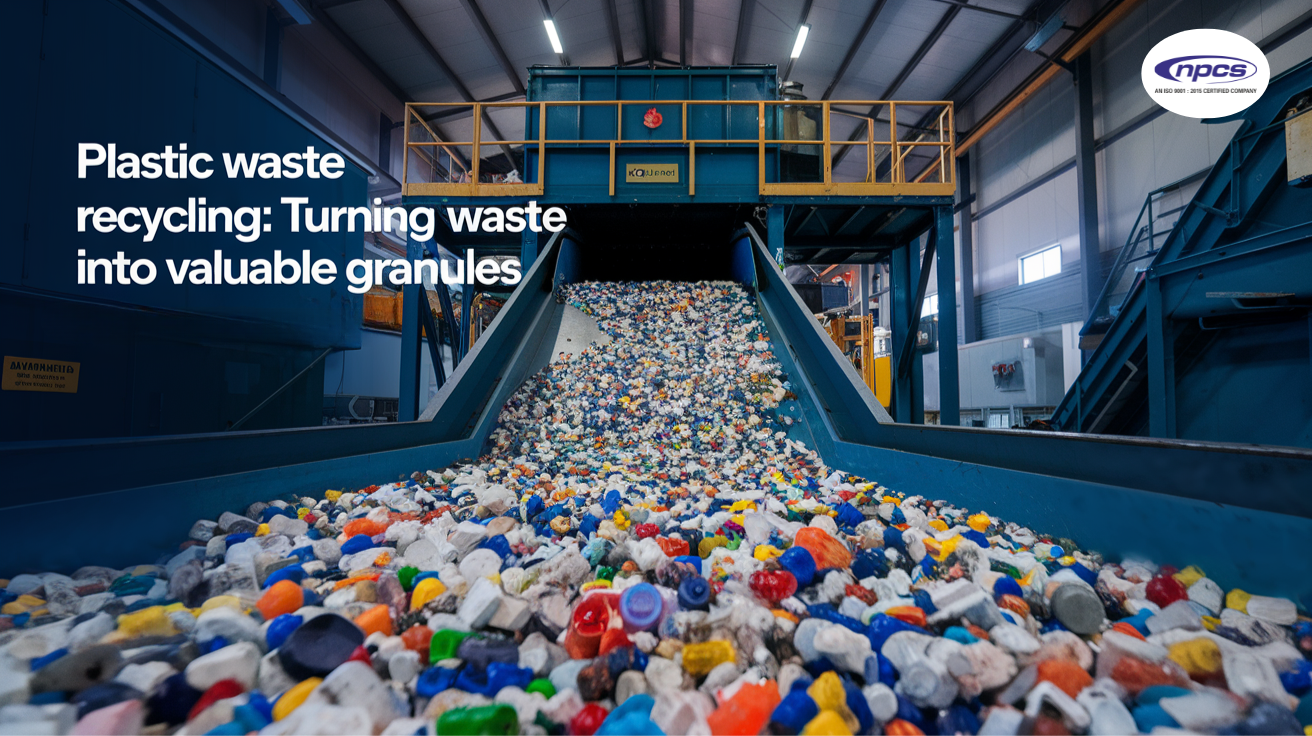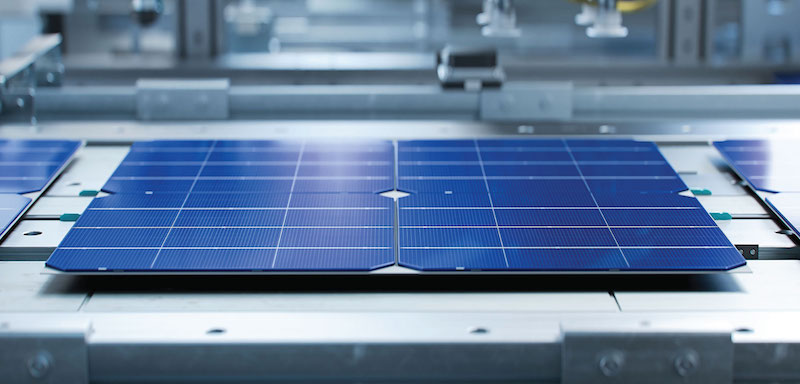Manufacturing Opportunities: The future is oriented towards clean, sustainable, and smart manufacturing and the potential overlaps between renewable energy, public health, and circular economies.
Thus, the business potential in the packaged drinking water, bamboo charcoal, aluminium recycling, and rice husk biomass pellets industries is easy to see.
These industries have a significant reserve of raw materials and tackle important social and environmental problems, and have considerable growth potential in global trade. For these reasons, entrepreneurs view such industries as practical, scalable and future-oriented for manufacturing.
Therefore, this guide offers insights to such entrepreneurs to help them identify potential manufacturing and value-adding opportunities, such as the estimated value of the market, the main drivers of demand and some potential strategies.
Global Market Perspective-Manufacturing Opportunities
It makes sense to evaluate the potential each market vertical will contribute to the overall value proposition of the business.
Although the market for packaged drinking water is the highest scaled and deeply penetrated within the tiered market structure, several other verticals such as bamboo charcoal, aluminium recycling, and rice husk biomass energy pellets are growing at much faster rates, albeit from much smaller market revenues.
New and innovative entrepreneurs can tap extremely profitable markets as long as they demonstrate an ability to pivot to meet the demands of the market and the concurrent sustainability challenges(Manufacturing Opportunities).
Furthermore, the aluminium recycling and bamboo charcoal, which also includes rice husk pellets, is almost certain to double in global demand as energy policies are becoming more aggressive to meet decarbonisation goals. Understanding the different opportunities in each of these sectors will be crucial for entrepreneurial bottom-up value proposition development.
Packaged Drinking Water-Manufacturing Opportunities
1.1 Industry Overview
The packaged drinking water industry extracts raw water from boreholes, municipal pipelines, and surface water and purifies and stabilizes it into a finished product that is ready for consumption.
The demand for bottled drinking water is on the rise due to urbanization, increased health consciousness, and the influence of tourism. Consumers recognize the health benefits of water over other beverages, which propels the industry forward.
Retail and institutional health markets are increasingly leaning towards functional, flavored, and alkaline water options, creating a wider gap for industry opportunities.
Read More: The Future of Bottled Water Manufacturing: A Step-by-Step Guide for First-Time Entrepreneurs
1.2 Raw Materials and Inputs-Manufacturing Opportunities
The packaging of drinking water primarily uses raw water, filtration media, and packaging materials. Sources of water include borewells, municipal pipelines, rivers, and lakes.
With water’s different characteristics, the treatment needed to be done is dependent on the water’s purity level. Sand filters, which serve to remove solids, are followed by activated carbon to eliminate chlorine, odors, and other organics.
Then, microfiltration as well as reverse osmosis membranes remove other impurities, microorganisms, and dissolved salts. \n\nA UV sterilizer is used to neutralize all the pathogens, and for the effective terminal disinfection, we use ozonation.
Additional calcium and magnesium minerals are added through the mineralization system for a better taste.
Packing Supplies: PET bottles, which are lightweight, inexpensive, recyclable, and plastic, are the most common for packaging. Over other brands, glass and aluminum bottles are typical for more expensive brands.
1.3 Manufacturing Methods-Manufacturing Opportunities
The first step is water treatment. In this step, raw water undergoes purification using sand filtering, activated carbon filtering, microfiltration, reverse osmosis, UV sterilization, and ozonation.
After this step, purified water moves to automated filling lines where machines rinse, fill, cap, label, and pack the bottles under the same sanitation protocols. A lot of modern systems even integrate in house seamless PET bottle blowing to remove logistics and ensure uniformity of the bottles.
1.4 Pavillion and Machinery
General plants consist of raw water pumps, sand filters, activated carbon filters, softeners, RO units, UV sterilizers, ozone generators, bottle rinsers, filler-cappers, blow molding machines, labelers, shrink tunnels, and palletizers. For the most part, Modern plants choose continuous flow layouts to reduce the risk of contamination by modern automation and to increase the rate of production.
1.5 Demand and Growth Drivers
An increase in health consciousness, technological advancement, tourism growth, and the introduction of new products such as mineralized water and flavored hydration products, all driving a rise in demand for products. Moreover, the demand for safe and healthy drinking water is unprecedented in areas with little or no tap-water systems. Initiatives of Sustainability, such as recyclable PET and refillable systems, similarly influence consumer demand(Manufacturing Opportunities).
1.6 Business Entrepreneurship
An entrepreneur’s main challenge in this field is understanding the regulations, ensuring that they obtain the necessary licenses, completing the ecosystem, controlling, and designing the sustainable and recyclable packaging. There is a lot of competition, so businesses need to focus on differentiation and optimizing the brand.
Bamboo Charcoal-Manufacturing Opportunities
2.1 Industry Overview
Bamboo charcoal is a rapidly emerging substitute for conventional and wood-based charcoal. Like all giant Grass, Bamboo, grows quickly, and sequesters carbon and can be harvested sustainably for ethically positive outcomes. Bamboo charcoal, unlike wood charcoal, has a wide range of other uses such as in the purification of water, air, and in cosmetics. This wide range of uses is what is driving the demand for biodegradable, natural, and non-toxic products to the consumers of the world.
2.2. Raw Materials and Supply Chain
Producers of bamboo charcoal primarily utilise mature bamboo culms which are about 4 to 5 years of age. Bamboo can regenerate from its root system so there are no need for plantations and bamboo charcoal producers will have sustainable and friendly raw supply.
2.3. Manufacturing Process
First to begin this process is the stage of drying, where fresh bamboo loses about 15 percent of its moisture content by drying, which can be done either naturally or mechanically.
Next is carbonization, which is the heating of bamboo in the absence of oxygen in kilns and furnaces at temperatures around 800 – 1200С to obtain a form of charcoal that is highly porous.
The next step is the activation process which involves introducing steam to the charcoal at a temperature of around 850, allowing the charcoal to obtain micro and mesopores that are suitable for various applications that require high adsorption capacity.
Activated bamboo charcoal is suitable for varying applications including the adsorption of contaminants in water, cosmetics, and other applications in high-end industries.
Read More: How to Start Manufacturing Business of Bamboo Charcoal
2.4 Plant layout and Machinery-Manufacturing Opportunities
Crumblers, driers, carbonization kilns, activation reactors, gas purifiers, condensers, and by-product recovery units are all standard equipment in the plants. These co-products are often included in integrated systems since secondary revenue can be obtained from bamboo vinegar and tar and at the same time the systems can be made more efficient.
2.5 Demand and Growth Drivers
Advantage of sustainability and the increasing versatility of activated charcoal in absorbing purification systems, the expanding product line in personal care, and the growing utilisation of biochar in agronomy or agriculture enhances the increasing more of the global market. \nConsequently, the market capture and demand utilisation of bamboo charcoal is increasing.
2.6 Entrepreneurial Considerations
For a business venture operational success, an uninterrupted supply of bamboo, efficient carbonisation technology, market diversification to activated charcoal and high quality product outputs are the minimum requirements. Also, value in entrepreneurship can be realised in the production and processing of cosmetic-grade charcoal briquettes or powders.
Aluminium Recycling Facility-Manufacturing Opportunities
3.1 Industry Overview
Turning scrap metal into secondary (high quality) aluminium and recycling aluminium requires only five percent of the energy expended to produce primary aluminium.
Because of this, the recycling of aluminium reduces emissions and production costs which enhances achievement of targets in global circular economy. The more lightweight materials that are required in vehicles, packaging, the construction sector, etc., the more important aluminium recycling is.
3.2. Raw Materials
Manufacturers recycle aluminum sourced from beverage cans, automotive parts, construction debris, industrial scrap, and end-of-life products. On a global scale, scrap availability is consistent and predictable, enabling the operation of supply chains.

3.3. Recycling Process-Manufacturing Opportunities
The first step is collection and sorting to separate aluminum by the type of alloy and the level of impurities in the alloy.
Next is a pretreatment step where the attributes of the aluminum are broken down by crushing and shredding. Then, the thermal decoating step removes the various coatings, paints, and plastics.
Refining and melting is when flux is added to the molten aluminum and the impurities are removed. This step is important to ensure a clean end product.
In the last step, the molten aluminum is cast into high-quality billets, ingots, and industrial sows from which a wide range of industrial products can be produced.
Read More: Aluminium Recycling Plant Production of Aluminium Ingots from Aluminium Scrap.
3.4. Advantages and Market Drivers
Recycling of aluminum is quite sustainable and this is a profitable opportunity for entrepreneurs. Low energy and production costs drive the operations of recycling, and emissions are reduced across the entire industry. Moreover, high recycling rates coupled with strong industrial demand due to regulation sustain entrepreneurship in this industry.
3.5 Challenges and Considerations
Imperfections in the processes of capital and loss management, such as impurity deposition, dross, and regulatory constraints, are the primary considerations. However, targeting operational profitability over the long-term is possible for such entrepreneurs.
Biomass Pellets from Rice Husk
4.1 Industry Overview-Manufacturing Opportunities
Biomass in the form of pellets is clean, renewable, and a substitute for fossil fuel. Rice husks are abundant in rice growing areas making this industry have and sustain low-cost feedstock. Furthermore, the industry works alongside several climate change mitigation measures. The industry focuses on the renewable generation of heat and power.
Read Our Book: Click Here
4.2 Properties and Advantages of Rice Husk Pellets
The heating value of rice husk pellets is about 3,000-3,600kcal/kg. The pellets, however, have a high ash content of about 15-20% due to high silica content. Yet, the pellets provide several positive aspects. They reduce waste, have low feedstock pollution, and diminish the major cause of field pea burning, which is the open field burning of agricultural residue.
4.3 Manufacturing Process
The first step is the drying step which reduces the husk moisture content to about 10-15.
The next step is called pelletizing. The husk is compressed into dense pellets cut cylinders by machines that apply high pressure.
Next in the sequence is cooling. Here the temperature is taken to the point where the structure of the rigid and hardens.
Next is the most pronounceable one, packaging. For the protection of the integrity of the bags in the transit to customers, the bags containing the pellets are placed in sturdy bags.
4.4 Equipment and Plant Layout
As noted earlier, each plant is fitted, and can operate, with a range of sieving machines, crushers, and dryers, as well as freezer and cooler benefit systems, bagging machines, dust collecting systems and a set of storage silos, allowing each plant to operate within efficiency and required standards.
Read Our Project Report: Click Here
4.5 Market Drivers and Applications
Clean, renewable and burnable fuels, while lower in emissions, are in demand in most of the European home heating markets. Additional, to the stream of policies to promote renewable energy, there are unmet industrial heating requirements. This results in increased demand and strong potential for export(Manufacturing Opportunities).
4.6 Entrepreneurial Considerations
The potential entrepreneur must focus on the establishment of a reliable feedstock supply system complemented with quality control system streamlining for the consistency of product quality, use of renewable energy, and development customer systems to provide a wider range of customers(Manufacturing Opportunities).
How NPCS Can Help You
Niir Project Consultancy Services (NPCS) Develops Detailed Project Reports Feasibility Studies. As a result, NPCS assists the entrepreneur with the development of Market Surveys Analysis Reports Tecnhno Economic Feasibility Reports.
This includes the availability of the raw materials, the process technology, the configuration of the plant, machinery, costs, expected profits, and legal compliance.
NPCS equips the entrepreneur with actionable, clear and unbiased information and insights to the risks, so NPCS increases the likelihood of a rational investment decision. NPCS has also extended these services to the development of packaged drinking water plants, bamboo charcoal units, recycling facilities of aluminium, and plants for the production of rice husk pellets.
Find the Best Idea for Yourself With our Startup Selector Tool
Summary
There is a significant opportunity for sustainable and meaningful entrepreneurial ventures in the fields of packaged drinking water, bamboo charcoal, aluminium recycling, and rice husk pellets. Each industry is built on ethical and sustainable values, and is supported by abundant and easily obtainable supplies while also addressing pressing ecological challenges.
Those entrepreneurs who have the ability to understand the relationships and flows of these supply chains will be able to identify and take advantage of highly profitable and beneficial opportunities. The coordinated and sustainable activities, combined with the quality and values of these industries will lead to a substantial and enduring impact contributing to a healthier and cleaner planet and communities(Manufacturing Opportunities).
FAQS
Q1: What are the legal and other requirements for starting a packaged drinking water enterprise?
Water producers need quality certifications for the water, licenses for food safety, and some clearances in regard to the environment. As for the Indian situation, the manufacturer will have to obtain BIS, FSSAI, and Pollution control approvals(Manufacturing Opportunities).
Q2: What about the profitability of bamboo charcoal production and woody charcoal production?
Bamboo Charcoal Production is more profitable due to the faster growth cycle of bamboo and the lower production cost due to the very low and sustainable cost to bamboo charcoal. This profitability is also enhanced by the sale of activated bamboo charcoal and the by products of bamboo charcoal such as vinegar and tar.
Q3: Do we really save a lot of energy by recycling aluminum?
Certainly. The recycling of aluminium is very energy efficient as it saves the energy that would go into the production of primary aluminium as recycled aluminium requires only 5 % of the energy.
Q4: What are the solutions to the increasing ash content of the produced rice husk pellets?
Co-blending stock of rice husk with low ash content biomass is an option of mitigating the increased ash content. Use of advanced burners that have regular ash removal designed for high-silica fuels also alleviates clinker formation.
Q5. What is the minimum viable size for a biomass pellet plant?
Biomass pellet plants with a raw material supply of 1-2 tonnes per hour can operate profitably. Larger companies provide effective servicing of industrial customers as they acquire economies of scale.
Q6. Can a startup combine multiple opportunities?
Yes, many entrepreneurs do combine these projects. Examples include using rice husk pellets as fuel for heating bamboo carbonization units or drying biomass with waste heat from the aluminium recycling process.
